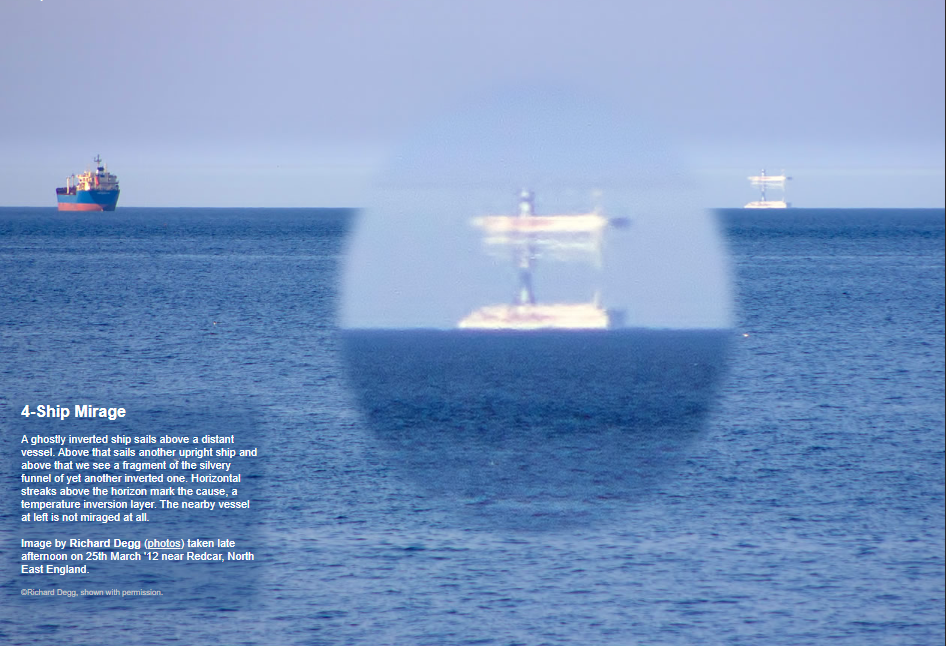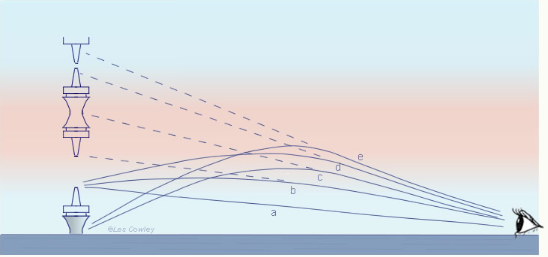OPOD - 4 ship superior mirage
OPOD - 4 Ship Superior Mirage: Exploring the Spectral Illusion
Have you ever witnessed a ghostly spectacle at sea, where ships seem to defy the laws of physics? In a rare occurrence known as a superior mirage, multiple images of ships can appear stacked above one another, creating a surreal and captivating sight. One such remarkable phenomenon was captured by Richard Degg in his photograph taken near Redcar, North East England, on the late afternoon of March 25th, 2012.
Superior mirages are named as such because the additional images appear above the original ship, defying our expectations. These mirages are quite rare, with the Redcar mirage being particularly extraordinary due to the presence of four distinct images. To understand how these mirages form, we must delve into the intricacies of temperature inversions and the refraction of light.
Temperature inversions occur when a layer of cold air rests beneath a layer of warmer air. In the case of superior mirages, the rays of light from the ship encounter these vertical temperature and density gradients, causing them to bend towards the denser and cooler layer. This bending creates a concave shape towards the sea or ground, distorting the appearance of the ship.
The specific form of the mirage depends on the precise temperature profile and gradients present in the atmosphere. Mirages can range from classical inverted images above the object to the ethereal cliffs and castles of a Fata Morgana. In the Redcar mirage, the temperature gradients yield weak and possibly multiple overlapping and tilted first inverted images. The upper erect image, if indeed it is erect, appears vertically compressed, while all the images are truncated to the left.
To understand the mechanics of a superior mirage, let's examine the path of different rays of light from the ship. Ray 'a,' originating from the ship's mast, passes through only cold air and undergoes minimal deviation. As a result, the lower image of the ship appears as it would without any mirage effect.
On the other hand, ray 'b' grazes the boundary between the cold and warm air layers, causing it to be refracted downwards. Refracted rays always curve towards the colder and denser air, making ray 'b' appear to originate from a point above the actual position of the ship. Similarly, ray 'c' from the ship's hull, with its increased angle to the sea, penetrates deeper into the cold-warm boundary and experiences stronger refraction. Consequently, it appears to originate from a point higher than ray 'b,' resulting in an inverted miraged image above the ship.
The complexity of the Redcar mirage is further amplified by the intricate temperature gradients present. This complexity can yield weak and potentially multiple overlapping and tilted first inverted images. As crossed rays give rise to inverted images, ray 'd' from the ship's mast, penetrating deep across the temperature gradient, is refracted strongly downwards, intersecting with ray 'e' to form yet another inverted image.
Witnessing a superior mirage, such as the 4-ship mirage captured by Richard Degg, is truly a remarkable experience. These optical illusions serve as a reminder of the fascinating interplay between light and atmospheric conditions. So, keep your eyes peeled when gazing out at the sea, for you never know when nature will treat you to a mesmerizing display of spectral wonders.

4-Ship Mirage
A ghostly inverted ship sails above a distant vessel. Above that sails another upright ship and above that we see a fragment of the silvery funnel of yet another inverted one. Horizontal streaks above the horizon mark the cause, a temperature inversion layer. The nearby vessel at left is not miraged at all.
Image by Richard Degg (photos) taken late afternoon on 25th March '12 near Redcar, North East England.
©Richard Degg, shown with permission.
A rare superior mirage. So named because the extra images are above the ship. Rare because there are four images.
Superior mirages result from cold air beneath warmer - a temperature inversion. Rays from the object are refracted by the vertical temperature/density gradients. Rays tend to curve towards the denser, cooler, layer and are thus generally concave towards the sea or ground.
The precise form of the optical distortion, mirage if there is more than one image formed, depends on the exact form of the temperature profile and gradients. Mirages can range from a classical inverted image above the object through to the towering cliffs and castles of a Fata Morgana.

At left the ray 'a' from the ship's mast passes through only cold air and is hardly deviated - the lower image of the ship appears it would be with no mirage taking place.
Ray 'b' from the same point on the ship grazes the boundary between the cold and warm air layers and is refracted downwards - refracted rays always curve towards the colder and denser air. To the eye, ray 'b' appears to be coming from a point above the real position of the ship.
Now look at one of the rays from the ship's hull - ray 'c'. Its increased angle to the sea causes it to penetrate deeper into the cold/warm boundary and it is refracted more strongly. To the eye it appears to come from a point higher than that of ray 'b'. The miraged image of the ship is inverted and above the ship itself.
Ray 'd' from the ship's mast also penetrates deep across the cold to warm air temperature gradient and is strongly refracted downwards again. Ray 'e' is even more strongly refracted. It crosses ray 'd' and forms yet another inverted image. Crossed rays give inverted images.
The Redcar mirage is more complicated than the above schematic. There are complexities in the temperature gradients that yield weak and possibly multiple overlapping and tilted first inverted image(s). The upper erect image, if indeed it is erect, is vertically compressed and all the images are truncated to the left.
Note: this article has been automatically converted from the old site and may not appear as intended. You can find the original article here.
Reference Atmospheric Optics
If you use any of the definitions, information, or data presented on Atmospheric Optics, please copy the link or reference below to properly credit us as the reference source. Thank you!
-
<a href="https://atoptics.co.uk/blog/opod-4-ship-superior-mirage/">OPOD - 4 ship superior mirage</a>
-
"OPOD - 4 ship superior mirage". Atmospheric Optics. Accessed on April 19, 2024. https://atoptics.co.uk/blog/opod-4-ship-superior-mirage/.
-
"OPOD - 4 ship superior mirage". Atmospheric Optics, https://atoptics.co.uk/blog/opod-4-ship-superior-mirage/. Accessed 19 April, 2024
-
OPOD - 4 ship superior mirage. Atmospheric Optics. Retrieved from https://atoptics.co.uk/blog/opod-4-ship-superior-mirage/.